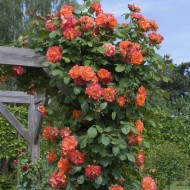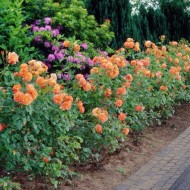The subtleties of planting, reproduction and cultivation of the park rose Westerland
Content
Breeding history of the variety
In 1969, the famous German breeder Reimer Kordes introduced a new variety of park roses - Westerland (Westerland). The new horticultural crop is the result of a selective crossing of two floribunda varieties: the white-pink-orange Circus and the golden-yellow Friedrich Worlein. The park rose got its name in honor of the small town of the same name on the island of Sylt (Germany).
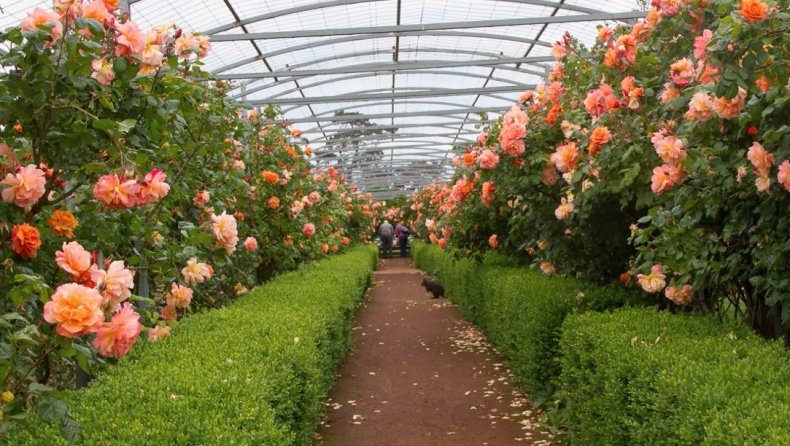
In 1974, the hybrid was awarded the ADR quality certificate. The flower was brought to Russia in the early 1990s. Due to the excellent varietal characteristics, the ornamental crop is grown in many regions of our country.
Description and photo of rose Westerland
Variety Westerland is characterized by intensive growth. So, the height of an adult shrub reaches 1.5-2.5 m. When grown in the form of a climbing rose, it can grow up to 3-4 m. The crown width depends on the chosen molding option, but on average it is at least 1-1.5 m. The shoots of the variety are resilient, elastic, highly branched, of medium thickness. The leaves are dark green in color with a beautiful glossy sheen. The shape of the leaf is obovate, elongated towards the tip.
Park rose Westerland has a spectacular appearance. During the flowering period, which lasts from May to September, the shrub is covered with semi-double type buds. The diameter of the flower reaches 10–11 cm. The peculiarity of the Westerland variety is a unique color and persistent aroma, which is felt 1 m from the bush itself. The middle of the bud is colored golden yellow. The petals play with shades of pale pink, coral, salmon, orange, yellow and gold.
Depending on the chosen pruning option, the flower can be grown on a trunk, a bush or as a climbing plant. Westerland looks interesting in solitary and composite plantings, as well as on arches, columns and walls of garden pavilions.
- Application in vertical gardening
- Recreation area decoration
- Decoration of paths in the garden
Advantages and disadvantages of the variety
Rose Westerland has not only a spectacular appearance, but also a number of other advantages. However, the negative aspects of the plant should not be ruled out.
- high decorative quality of the shrub;
- the possibility of using in landscape design and floristry;
- preservation of the decorative qualities of the bud in the bouquet;
- long flowering period;
- persistent and rich aroma;
- unique color of buds;
- unpretentious care;
- resistance to natural phenomena and anomalies.
- the need to form the crown due to the intensive growth of shoots;
- high probability of breaking off branches with increased bud formation;
- average winter hardiness;
- freezing of young shoots.
Video "Westerland Park Chameleon Rose"
This video shows what an ornamental shrub looks like.
Subtleties of planting and caring for a Westerland rose
According to experienced gardeners, the Westerland variety is considered one of the most unpretentious to care for. Compliance with certain agrotechnical measures, which we will consider further, will help to grow a spectacular rose garden in the garden.
Planting recommendations
You can plant seedlings in unprotected soil in spring and autumn. Spring planting is considered more successful, since the young bush has enough time to adapt to new growing conditions.
For the Westerland rose, a section of the garden that is closed from the wind and draft is selected. At the same time, active solar lighting is undesirable for the plant. Unfortunately, UV rays cause the buds to burn out. An ornamental shrub can be grown in partial shade.
The soil should be moderately light and well drained. The best option is black soil with an acidity level of about 5.5–6.5 pH. Horticultural crops do not tolerate excess moisture in the soil. For this reason, a rose seedling should not be planted in lowlands where rainwater collects. The groundwater level should be no higher than 1.5–2 m. Otherwise, rotting of the root collar and the death of the shrub is possible.
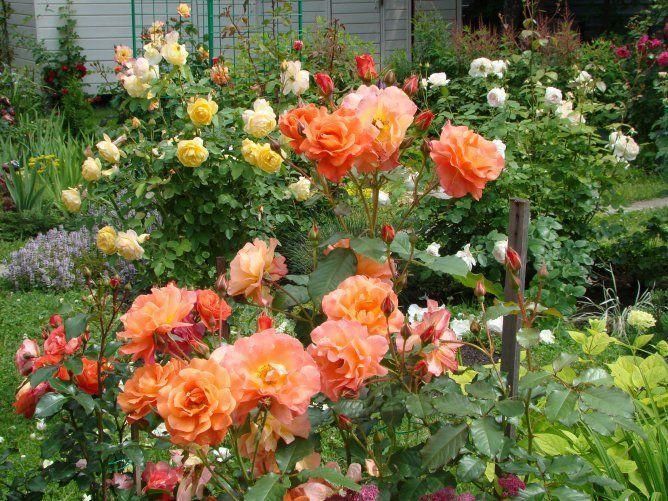
Watering, loosening and mulching
The first 14 days after planting in a permanent place of growth, the shrub is watered every day. It is better to water the plant in the early morning or late evening. For irrigation, use rain or settled cold water. As the plants grow, they increase the interval between waterings. An adult bush is moistened 2-3 times a week. Please note that with frequent natural precipitation, the rose garden does not require additional soil moisture.
After each watering, when the water is completely absorbed, shallow loosening is carried out. The loosening procedure allows you to saturate the soil with oxygen, which is necessary for the full development of the root system. Then the shrub is mulched with peat, hay or straw. Mulch helps maintain optimal moisture levels in the substrate and acts as a barrier to the growth of weeds.
Fertilization
To increase bud formation, ornamental shrubs are fed with mineral fertilizers. In the spring, nitrogen-containing agents are introduced, which contribute to the active growth of green mass. During the growing season, the rose is fed with potash and phosphorus fertilizers.
Westerland responds well to superphosphate feeding. Superphosphates can be added every 2-3 weeks.
In order to prevent a burn of the root system, which can be provoked by fertilizers, the plant is preliminarily watered abundantly.
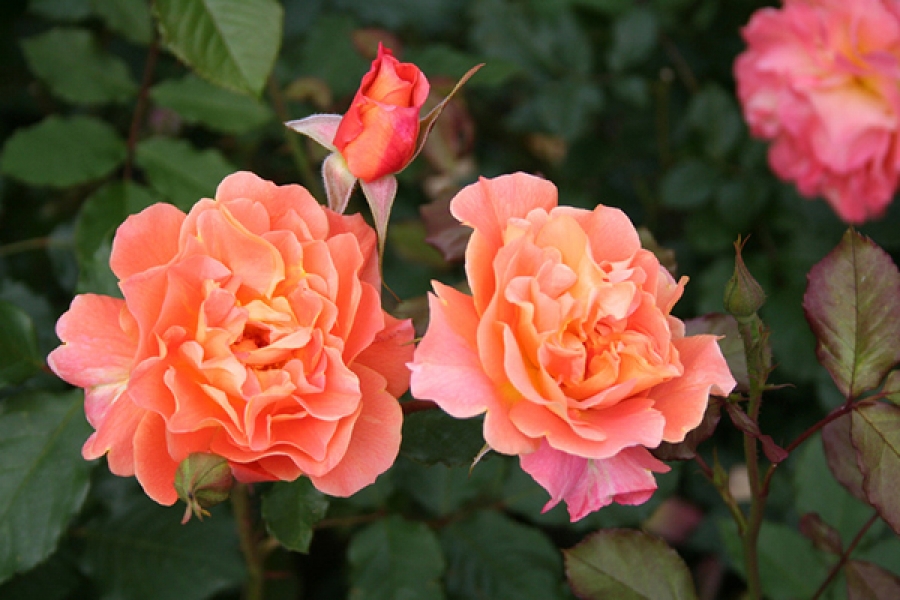
Reproduction methods
You can propagate a park rose vegetatively or by cuttings.
Vegetative propagation refers to the method of dividing the bush. At the end of March or the very beginning of April, the overwintered ornamental bush is dug up and divided into several equal parts. Each shoot is cut to 3-4 buds. The roots of the seedlings are soaked in a biostimulator of growth "Epin", "Kornevin" or "Zircon". Planting is carried out according to the traditional scheme.
Lignified shoots are cut in early July. Suitable for reproduction are cuttings cut from the upper and middle parts of the shoots with 1-2 healthy buds. The optimal cutting length is from 10 to 15 cm.
Cuttings soaked in a solution of an immunomodulator of growth are planted in a nutrient medium and placed under a hood. Periodically, the plants are ventilated and moisturized. When the first leaves appear, the protective cap is removed. Planting in open ground can be carried out only when at least three fully formed, developed and healthy leaves are formed on the handle.

Preparation for wintering
Many novice gardeners are interested in the question of whether it is necessary to shelter Westerland for the winter. The rose grown in the south does not require additional shelter. It is enough to sprinkle the trunk circle with peat, dry fallen leaves and river sand a little.
As for the central and northern regions, it is better to insulate the rose bushes cultivated here. Peat, hay, straw and dry opal foliage are used to cover the root part. The stems of the garden culture, in turn, are covered with agrofibre or any other non-woven covering material.
Diseases and pests of the variety
Common diseases of the cultivar are rust and gray rot. To combat rust, use a 2% Bordeaux mixture or a solution of copper sulfate. For the prevention and treatment of gray rot, a solution of potassium permanganate is used. Treatment with fungicides "Fundazol", "Ridomil Gold", "Topaz", "Profit Gold" and others will be more effective.

Westerland is affected by spider mites, rosacea aphids, scale insects and slobbering pennies. To prevent insects from destroying the rose, insectoacaricides Aktara, Fitoverm, Inta-Vir and Decis should be used.
Gardeners reviews
“There are dozens of roses growing in our garden at our dacha, but I consider the Westerland variety one of the most interesting. If you choose the right place for planting, the plant will delight you with abundant and rich flowering all summer ”.
“The Westerland rose looks great in a variety of park compositions. In addition, the flower holds its shape for a long time and retains its color when cut. I consider this variety to be one of the best in my rose garden. "
The Westerland cultivar is known to many gardeners, landscape designers and florists. All of them mark the exquisite appearance of the plant and its pleasant aroma.

